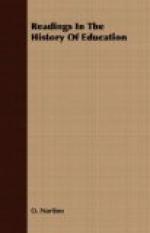[Footnote 46: For the text of this charter in full, see D.C. Munro, l.c. p. 7.]
[Footnote 47: Matthew Paris, Chronica Majora, III, 166-169.]
[Footnote 48: Chart. Univ. Paris., I, p. 119.]
[Footnote 49: Kashdall, I, pp. 11, 12.]
[Footnote 50: Chart. Univ. Paris., II, No. 578.]
[Footnote 51: Documents printed by Denifle, Die Universitaeten, etc., pp. 801-803.]
[Footnote 52: Document printed by Rashdall, II, Pt. II, p. 746.]
[Footnote 53: Charter of Harvard College, 1650.]
[Footnote 54: Charter of Brown University, 1764.]
[Footnote 55: See Compayre, “Abelard,” pp. 41-45, and 35-41.]
[Footnote 56: Fournier, Statuts, etc., III, No. 1644.]
IV
UNIVERSITY EXERCISES
The ways and means of teaching in mediaeval universities were few and simple in comparison with those of our own times. The task of the student was merely to become acquainted with a few books and to acquire some facility in debate. The university exercises were shaped to secure this result. They consisted in the Lecture, the Disputation or Debate, the Repetition, the Conference, the Quiz, and the Examination.
Of these the first two and the last were by far the most important; they are described in detail below. The Repetition, given in the afternoon or evening, was either a detailed discussion of some point which could not be treated in full in the “ordinary” lecture, or a simple re-reading of the lecture, sometimes accompanied by catechism of the students upon its substance. The Conference was an informal discussion between professor and students at the close of a lecture, or a discussion of some portion of the day’s work by students alone. The Quiz was often held in the afternoon at the student’s hall or college, by the master in residence there, as described on page 132.
(a) The Lecture
Lectures were of two kinds,—“ordinary,” and “extraordinary” or “cursory.” The former were given in the morning, by professors; the latter in the afternoon, either by professors or by students about to take a bachelor’s degree.
The purpose of the lecture was to read and explain the text of the book or books of the course. The character of the lecture was largely determined by the fact that all text-books, practically to the year 1500, were in manuscript, and by the further fact that many students seem to have been unable or unwilling to purchase or hire copies. A large part of the lecturer’s time was thus consumed in the purely mechanical process of reading aloud the standard text and comments. To these he might add his own explanations; but the simple ability to “read the book” intelligently was sufficient to qualify a properly licensed Master, or a Bachelor preparing to take the Master’s degree, to lecture on a given subject. This accounts for the fact that youths of seventeen or eighteen might be found giving occasional lectures, and that regular courses were given by those not much over twenty-one.




